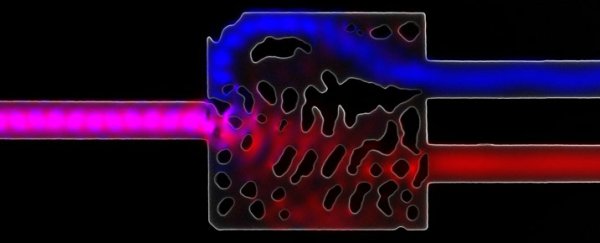Researchers have come up with an efficient way of transporting data between computer chips using light rather than electricity. Not only does this mean that computers will be able to transmit data much, much faster, it also means we could build machines that consume far less energy.
We're already able to send data in the form of photons at incredible speeds through the optical fibres that make up our Internet, but right now when this data hits our computers, it has to slow down so it can be converted into electrons and pushed through wires around our devices.
This process isn't just slow, it's also energy intensive, and it's responsible for making our computers so hot. "Up to 80 percent of the microprocessor power is consumed by sending data over the wires," one of the researchers, Jelena Vuckovic from Stanford University in the US, said in a press release.
But while engineers are getting very close to creating computer chips that can process light, they've struggled to find an efficient way to transmit that light across the thousands of different connections, known as interconnects, between them. In theory, light can be beamed between chips via silicon structures that bend it to the desired location, but these are incredibly difficult to build, and having to create a new silicon structure to replace every single wire inside just one computer could be next to impossible.
Now the Stanford University team has come up with a better solution, by developing an inverse design algorithm that tells them exactly how to build the silicon structures they need to perform a desired task. They've already used the algorithm to design a working optical circuit, and have made several copies in their lab.
Reporting in Nature Photonics, the team has now demonstrated that these devices worked perfectly, despite tiny imperfections in the structures. "Our manufacturing processes are not nearly as precise as those at commercial fabrication plants," said Alexander Piggott, who worked on the algorithm. "The fact that we could build devices this robust on our equipment tells us that this technology will be easy to mass-produce at state-of-the-art facilities."
So how exactly do you build a silicon interconnector? Basically it involves layering slices of silicon that are so thin that more than 20 of them could sit side-by-side in the diameter of a human hair. Light easily passes through silicon, but is also bends as it does so. By designing very precise segments of silicon and pairing them together - according to the instructions of the algorithm - the team are able to create switches or conduits that control the flow of photons, just like wires currently do with electrons.
"Our structures look like Swiss cheese but they work better than anything we've seen before," said Vuckovic.
By creating an algorithm that automates the development of these complex Swiss cheese silicon structures, the team has essentially "set the stage for the next generation of even faster and far more energy-efficient computers that use light rather than electricity for internal data transport," as the press release explains.
The algorithm could also be used to find design solutions to many other communication problems - all a researcher needs to do is plug in their desired result, and the algorithm will come up with a plan. We're pretty excited to see what they do with it next.
